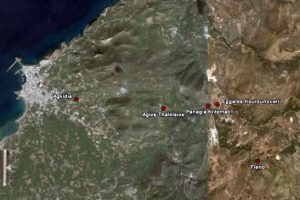Waterworks
The construction of the impressive 11 km long aqueduct dates from the end of the 6th century BC. The aqueduct was constructed to transfer water from the rich springs of Flerio to the town of Naxos (Chora). It is a structure made of clay module pipes connected to each other. The aqueduct starts from a river basin carved into the rock, nowadays located underneath a traditional windlass well in Flerioand which used to be the water collection point. Starting from the river basin, the aqueduct follows a journey through the areas of Agios Thalelaios and Agidia, and across the plain of Katsagra, ending at the capital.

Hydria Virtual Museum
The aqueduct was built in phases (in use from the end of the 6th century BC until the 8th century AD). Already in the first phase of construction it was necessary to dig a tunnel through the mountain in the north part of the Flerio plain, in order to best deploy water distribution to the fertile areas of the island on the way to the city. Therefore, a 230 m long tunnel was opened with its starting point in the lowest col of the Fleriobasin, in the north of the valley. It is estimated that the tunnel was used for the collection of additional quantities of water also from the Kinidaros region (village to the northeast of Melanes).
The tunnel has a sediment shaft and its starting point is a dome-shaped construction, which was aggregated later, during the Roman period, when the aqueduct was reconstructed. The entrance of the tunnel was discovered in 2003.

Hydria Virtual Museum
The initial carved structure of this part of the aqueduct is very similar to the TUNEL OF EYPALINOS in Samos Island. This similarity is probably more than accidental, as there is evidence indicating the established relations between the island of Naxos and the city of Megara (in Attica), where Eupalinos came from. But there is also evidence indicating the relations between the tyrant of Naxos, Ligdamis, and the tyrant of Samos, Polycratis.
One of the most important characteristics of the aqueduct of Flerio is the design of its route: The aqueduct follows the boundary between the lowest cultivated soils and the higher infertile land, making possible the irrigation of all the cultivations along its route, using distribution tanks.
The clay pipes were occasionally replaced by new ones, due to the salt sediment which from time to time blocked the water flow. During Roman times, a radical reformation of the aqueduct took place, maintaining the initial route and constructing a stone-built channel made of limestone and lime-mortar, which was underground in some parts and above ground in others. In the 4th century AD, the built channel was replaced by a new one similar to the first, which remained in use until the 8th century AD.
The aqueduct of Flerio constitutes a very important example of technical work, as its construction maintained life in the town of Naxos (Chora), and irrigated the fertile regions of the countryside with the minimum possible intervention to the natural ambience. Its realization stands as testimony to solid social cohesion and a central administration.